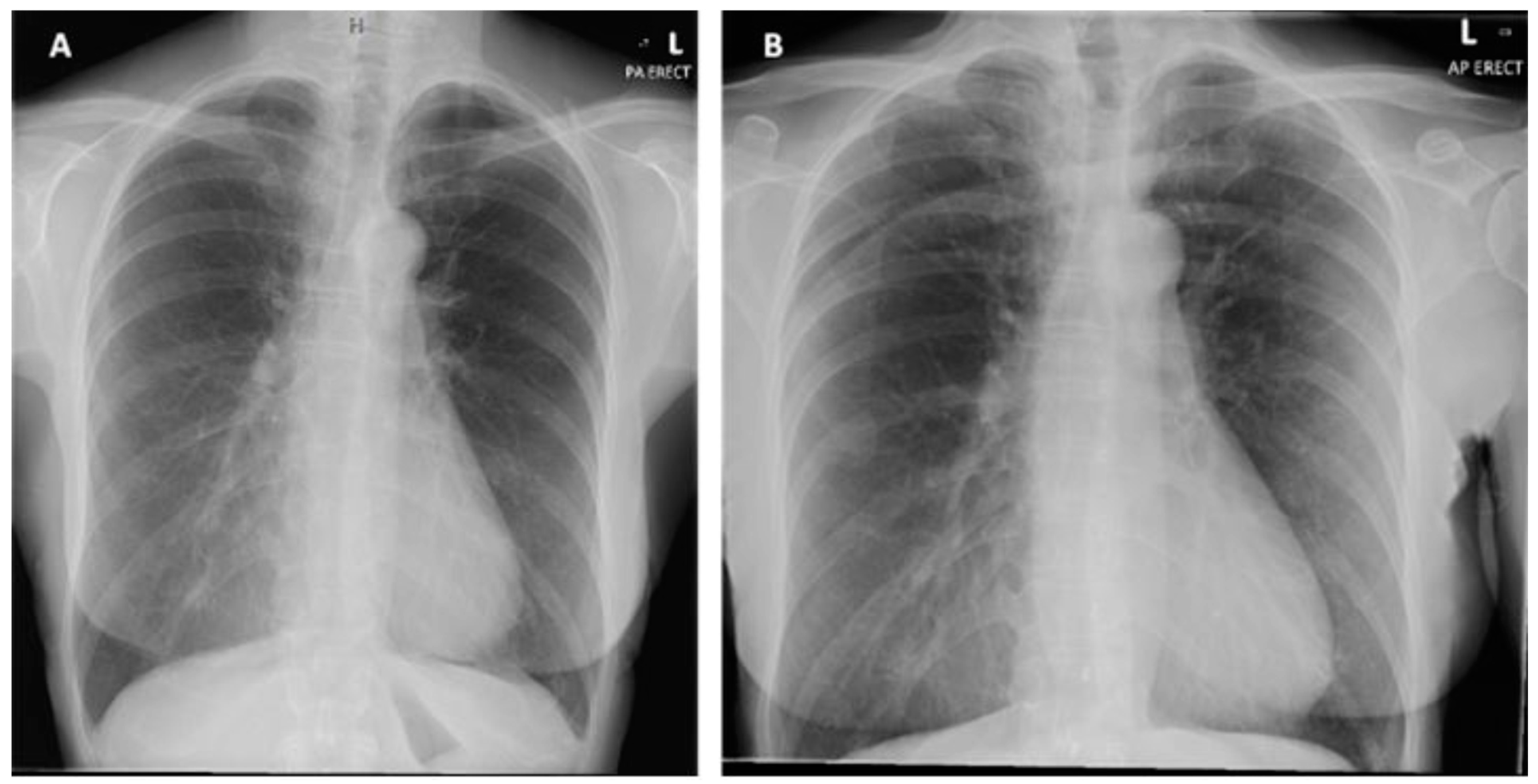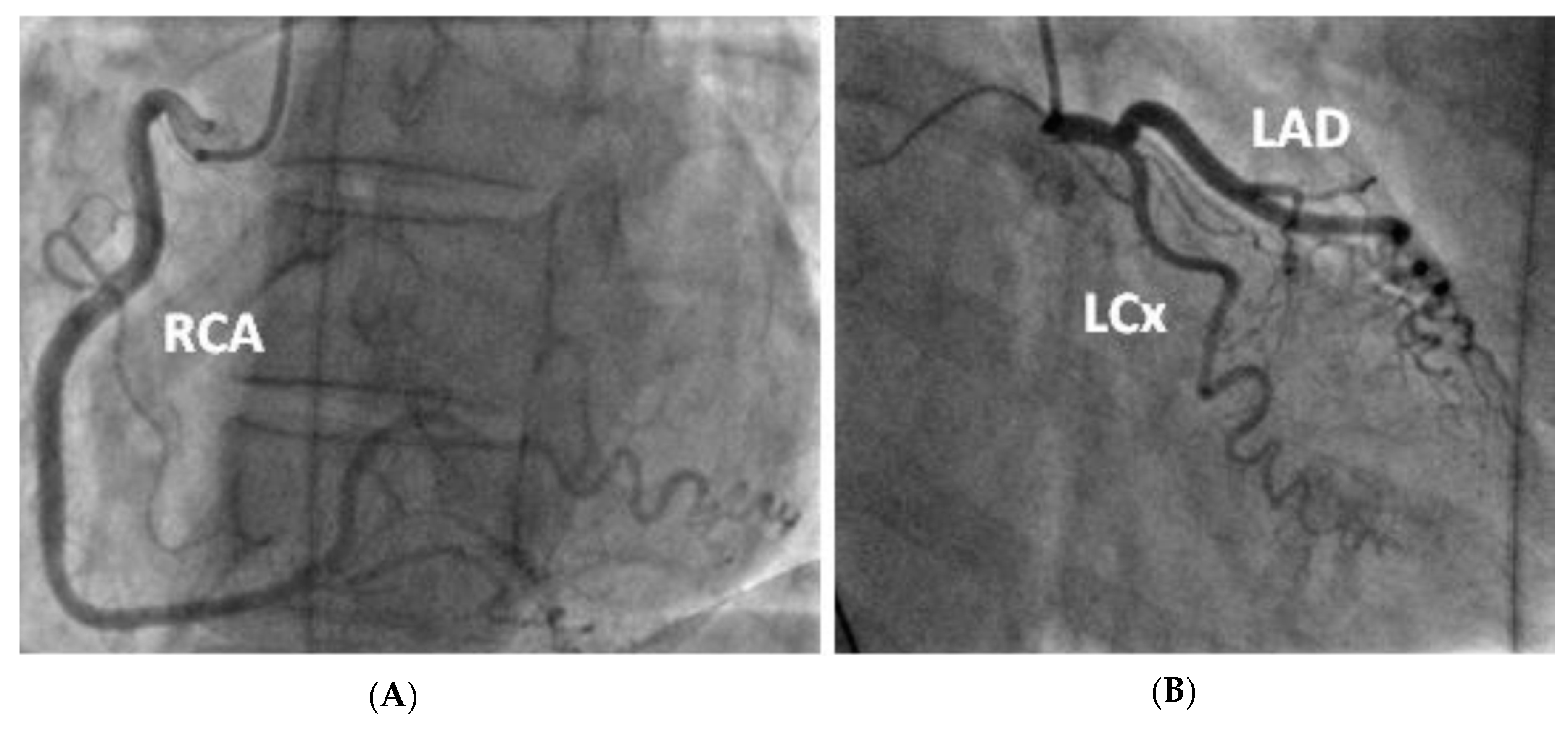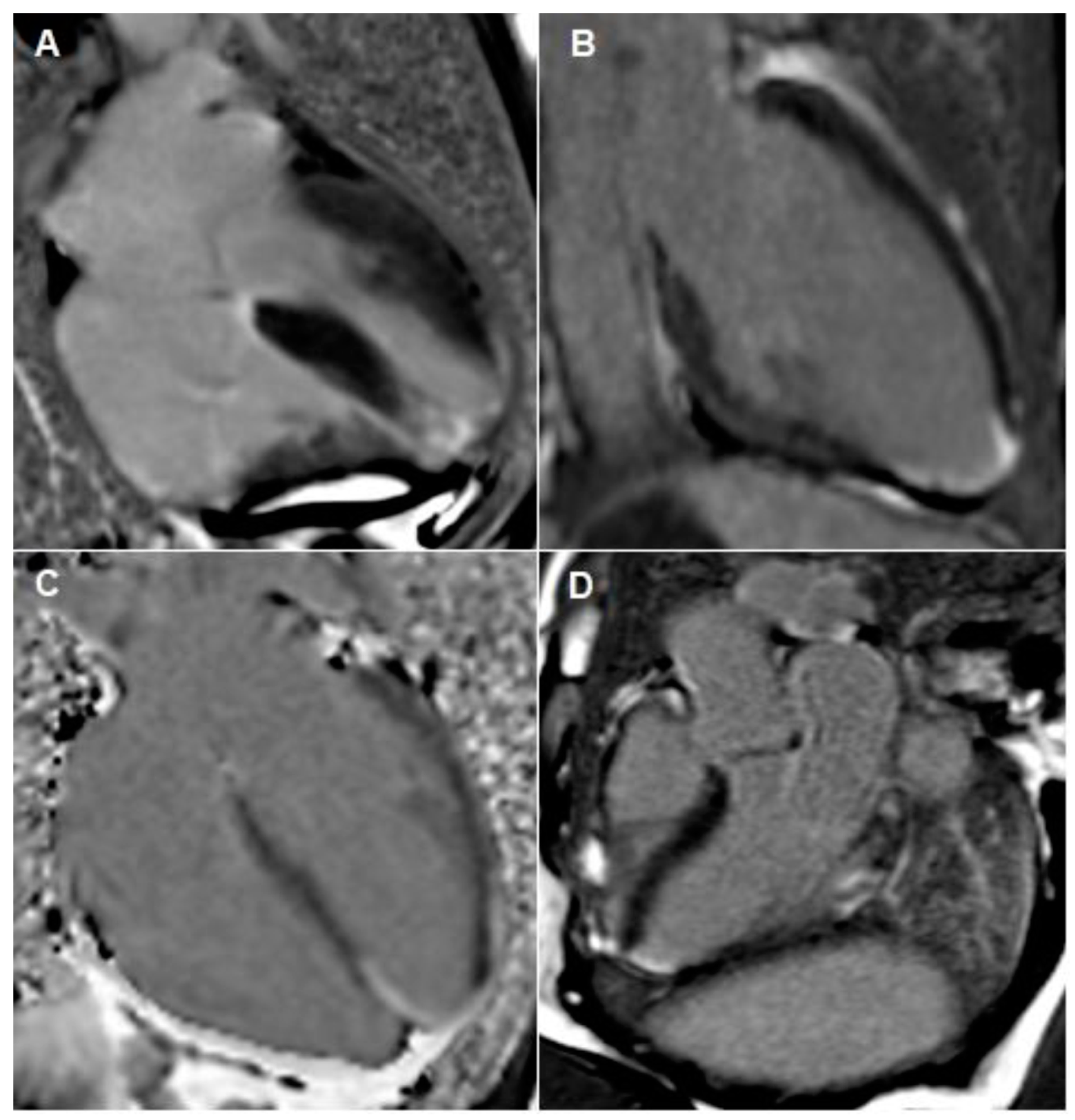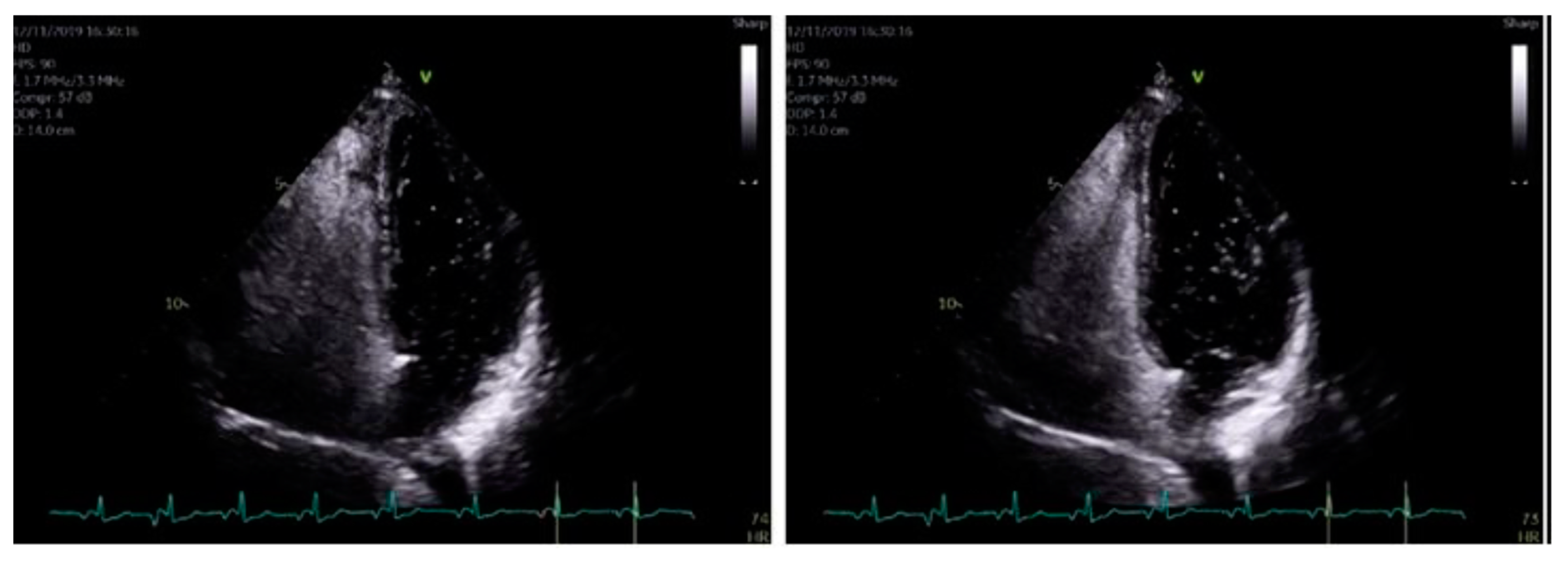Recurrent Episodes of Acute Myocardial Infarction Secondary to Paradoxical Coronary Artery Embolism
Abstract
:1. Introduction
2. Case Presentation
3. Investigations, Results and Treatment
4. Outcome and Follow-Up
5. Discussion
Author Contributions
Funding
Institutional Review Board Statement
Informed Consent Statement
Conflicts of Interest
References
- Hakim, F.A.; Kransdorf, E.P.; Abudiab, M.M.; Sweeney, J.P. Paradoxical Coronary Artery Embolism—A Rare Cause of Myocardial Infarction. Heart Views 2014, 15, 124–126. [Google Scholar] [CrossRef] [PubMed]
- Hakman, E.N.; Cowling, K.M. Paradoxical Embolism. In StatPearls; StatPearls Publishing: Treasure Island, FL, USA, 2022. Available online: https://www.ncbi.nlm.nih.gov/books/NBK470196/ (accessed on 8 September 2021).
- Agarwal, S.K.; Binbrek, A.S.; Thompson, J.A.; Siddiqui, S.A. Massive pulmonary embolism and acute limb ischaemia in a patient of hereditary spherocytosis and patent foramen ovale. Heart Lung Circ. 2010, 19, 742–744. [Google Scholar] [CrossRef] [PubMed]
- Wachsman, D.E.; Jacobs, A.K. Paradoxical coronary embolism: A rare cause of acute myocardial infarction. Rev. Cardiovasc. Med. 2003, 4, 107–111. [Google Scholar] [PubMed]
- Woods, T.D.; Patel, A. A Critical Review of Patent Foramen Ovale Detection Using Saline Contrast Echocardiography: When Bubbles Lie. J. Am. Soc. Echocardiogr. 2006, 19, 215–222. [Google Scholar] [CrossRef] [PubMed]
- Hirschwald, A.; Cohnheim, J. Lectures on General Pathology: A Handbook for Students and Students; Report No.: 1882th; New Sydenham Society: London, UK, 1882. [Google Scholar]
- Namazi, M.H.; Biglari, M.; Khani, M.; Eslami, V.; Movahed, M.R. Acute Myocardial Infarction Secondary to Suspected Paradoxical Emboli through Patent Foramen Ovale in a Young Woman. Available online: https://www.radcliffecardiology.com/articles/acute-myocardial-infarction-secondary (accessed on 20 February 2020).
- Khistriya, A.; Nahas, R.; Rahmani, M.J.H. Stroke and patent foramen ovale: Intervene or wait. Case Rep. 2015, 2015, bcr2014208866. [Google Scholar] [CrossRef] [PubMed] [Green Version]
- Shahi, N.; Nair, R. Paradoxical digital ischaemia. Case Rep. 2010, 2010, bcr1020092413. [Google Scholar] [CrossRef] [PubMed] [Green Version]
- Shibata, T.; Kawakami, S.; Noguchi, T.; Tanaka, T.; Asaumi, Y.; Kanaya, T.; Nagai, T.; Nakao, K.; Fujino, M.; Nagatsuka, K.; et al. Prevalence, Clinical Features, and Prognosis of Acute Myocardial Infarction Attributable to Coronary Artery Embolism. Circulation 2015, 132, 241–250. [Google Scholar] [CrossRef] [PubMed] [Green Version]
- Jamiel, A.; Alsaileek, A.; Ayoub, K.; Omran, A. Paradoxical embolism in acute myocardial infarction in a patient with congenital heart disease. Heart Views 2012, 13, 111–113. [Google Scholar] [CrossRef] [PubMed]
- Boumaaz, M.; Asfalou, I.; Hamami, A.; Raissouni, M.; Lakhal, Z.; Benyass, A. Myocardial Infarction Caused by an Enclosed Thrombus in a Patent Foramen Ovale. J. Saudi Heart Assoc. 2020, 32, 204–207. [Google Scholar] [CrossRef] [PubMed]
- Giblett, J.; Abdul-Samad, O.; Shapiro, L.; Rana, B.; Calvert, P. Patent Foramen Ovale Closure in 2019. Interv. Cardiol. Rev. 2019, 14, 34. [Google Scholar] [CrossRef] [PubMed] [Green Version]
- Overview|Percutaneous Closure of Patent Foramen Ovale for the Secondary Prevention of Recurrent Paradoxical Embolism in Divers|Guidance|NICE. Available online: https://www.nice.org.uk/guidance/ipg371 (accessed on 20 February 2020).





| Value | 04/11/19 | 05/11/19 | 06/11/19 | 07/11/19 | 11/11/19 | 12/11/19 | 13/11/19 | 14/11/19 | 17/01/20 | 18/01/20 | 19/01/20 | 20/01/20 | 26/01/20 | 17/02/20 |
|---|---|---|---|---|---|---|---|---|---|---|---|---|---|---|
| Hb | 152 H | 138 | 156 H | 162 H | 145 | 130 | - | - | 147 | - | - | 135 | 138 | 153 H |
| WBCC | 10.4 | 8.5 | 9.3 | 7.6 | 6.8 | 7.1 | - | - | 9.9 | - | - | 9.3 | 6.8 | 9.1 |
| PLT | 228 | 245 | 265 | 258 | 278 | 250 | - | - | 254 | - | - | 238 | 258 | 312 |
| INR | 1.0 | 1.1 | 1.0 | - | - | - | - | - | 1.1 | - | - | - | 1.4 | 1.1 |
| DD | - | 0.27 | - | - | - | - | - | - | - | - | - | - | - | 0.27 |
| Na | 140 | - | 143 | 142 | 140 | - | - | - | 138 | - | - | 138 | 139 | 142 |
| K | 4.3 | - | 4.0 | 4.1 | 4.1 | - | - | - | 4.1 | - | - | 4.4 | 4.4 | 5.3 H |
| Urea | 4.1 | - | 2.4 | 3.0 | 2.9 | - | - | - | 3.3 | - | - | 2.9 | 1.9 L | 4.0 |
| Cr | 58 | - | 69 | 65 | 56 | - | - | - | 47 | - | - | 45 | 54 | 59 |
| eGFR | 90 | - | 73 | 79 | >90 | - | - | - | >90 | - | - | >90 | >90 | 88 |
| CRP | - | - | <1 | <1 | <1 | - | - | - | <1 | - | - | <1 | <1 | - |
| Trop | 25–28 H | - | 587 H | 461 H | 130 H | 86 H | 48 H | 36 H | 173 H | 1017 H | 532 H | 375 H | - | 7 |
Publisher’s Note: MDPI stays neutral with regard to jurisdictional claims in published maps and institutional affiliations. |
© 2022 by the authors. Licensee MDPI, Basel, Switzerland. This article is an open access article distributed under the terms and conditions of the Creative Commons Attribution (CC BY) license (https://creativecommons.org/licenses/by/4.0/).
Share and Cite
Singh, M.; Gomes, A.T.; Hill, P.; Saha, A. Recurrent Episodes of Acute Myocardial Infarction Secondary to Paradoxical Coronary Artery Embolism. Cardiogenetics 2022, 12, 246-252. https://doi.org/10.3390/cardiogenetics12030023
Singh M, Gomes AT, Hill P, Saha A. Recurrent Episodes of Acute Myocardial Infarction Secondary to Paradoxical Coronary Artery Embolism. Cardiogenetics. 2022; 12(3):246-252. https://doi.org/10.3390/cardiogenetics12030023
Chicago/Turabian StyleSingh, Mita, Ana Teresa Gomes, Paul Hill, and Ansuman Saha. 2022. "Recurrent Episodes of Acute Myocardial Infarction Secondary to Paradoxical Coronary Artery Embolism" Cardiogenetics 12, no. 3: 246-252. https://doi.org/10.3390/cardiogenetics12030023
APA StyleSingh, M., Gomes, A. T., Hill, P., & Saha, A. (2022). Recurrent Episodes of Acute Myocardial Infarction Secondary to Paradoxical Coronary Artery Embolism. Cardiogenetics, 12(3), 246-252. https://doi.org/10.3390/cardiogenetics12030023






